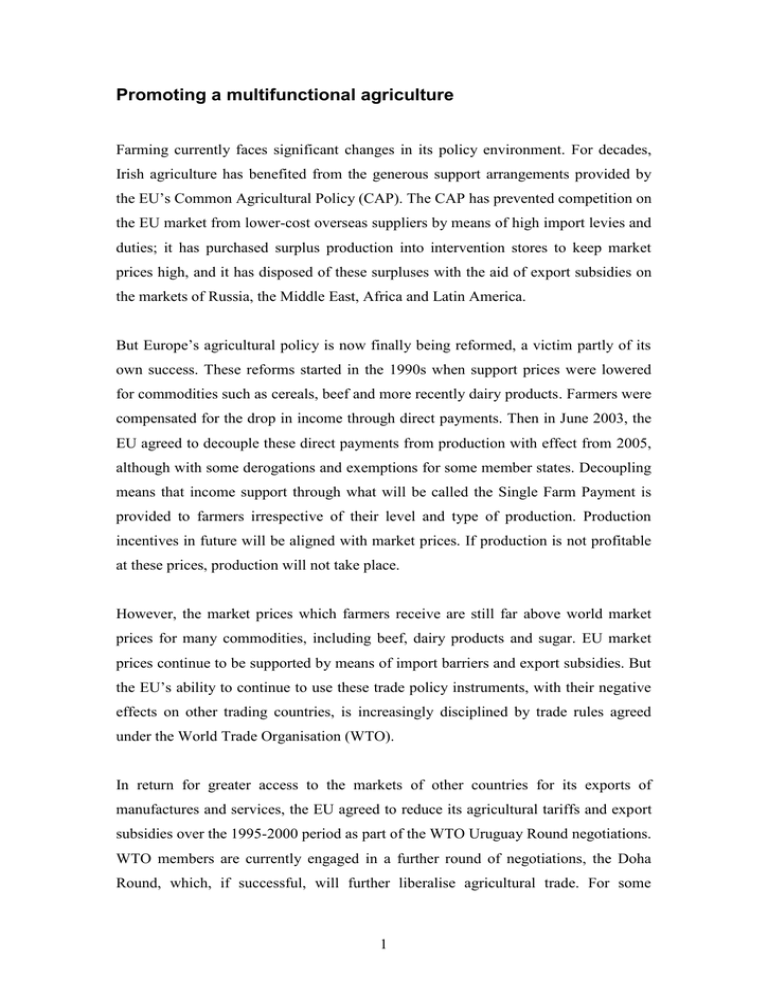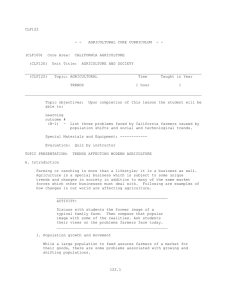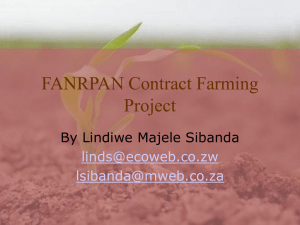Promoting a multifunctional agriculture
advertisement

Promoting a multifunctional agriculture Farming currently faces significant changes in its policy environment. For decades, Irish agriculture has benefited from the generous support arrangements provided by the EU’s Common Agricultural Policy (CAP). The CAP has prevented competition on the EU market from lower-cost overseas suppliers by means of high import levies and duties; it has purchased surplus production into intervention stores to keep market prices high, and it has disposed of these surpluses with the aid of export subsidies on the markets of Russia, the Middle East, Africa and Latin America. But Europe’s agricultural policy is now finally being reformed, a victim partly of its own success. These reforms started in the 1990s when support prices were lowered for commodities such as cereals, beef and more recently dairy products. Farmers were compensated for the drop in income through direct payments. Then in June 2003, the EU agreed to decouple these direct payments from production with effect from 2005, although with some derogations and exemptions for some member states. Decoupling means that income support through what will be called the Single Farm Payment is provided to farmers irrespective of their level and type of production. Production incentives in future will be aligned with market prices. If production is not profitable at these prices, production will not take place. However, the market prices which farmers receive are still far above world market prices for many commodities, including beef, dairy products and sugar. EU market prices continue to be supported by means of import barriers and export subsidies. But the EU’s ability to continue to use these trade policy instruments, with their negative effects on other trading countries, is increasingly disciplined by trade rules agreed under the World Trade Organisation (WTO). In return for greater access to the markets of other countries for its exports of manufactures and services, the EU agreed to reduce its agricultural tariffs and export subsidies over the 1995-2000 period as part of the WTO Uruguay Round negotiations. WTO members are currently engaged in a further round of negotiations, the Doha Round, which, if successful, will further liberalise agricultural trade. For some 1 commodities, this could require further reductions in EU support prices beyond those currently agreed under the successive rounds of CAP reform. Farming will adjust to competing in a more market-oriented environment, but many people are concerned about the likely impact on the environmental values produced by farming – the habitats, bio-diversity and pleasant and varied landscapes associated with current farming practice. It is argued that, at the same time as performing its traditional role as a food producer, agriculture produces environmental values as well as contributing to rural development and the maintenance of cultural heritage. Many people now talk of the ‘multifunctional’ role of agriculture to emphasise the way in which food production is linked to multiple outputs from farming. There is indeed evidence that the general public appreciate and are willing to pay for particular features of the rural landscape and the rural environment. Researchers at a recent Teagasc conference reported survey evidence that people were willing to pay up to €640 per hectare for more diverse and attractive landscapes than for monotonic or untidy landscapes. Increasingly, public policy has moved to remunerate farmers for the production of what economists refer to as ‘public goods’. This is done in two ways. First, farmers in receipt of the new decoupled payment must agree to keep their land in good agricultural and environmental condition as well as comply with the minimum statutory requirements for environmental protection, the identification and registration of animals, animal welfare and public, animal and plant health. This includes the EU water quality directive designed to protect water against pollution caused by nitrates. The decoupled payments can be reduced or removed completely if this requirement is breached. In EU jargon, this is referred to as ‘crosscompliance’. In addition, farmers can be paid for going beyond the minimum statutory requirements by enrolling their land in the Rural Environment Protection Scheme (REPS). Under the current agri-environment scheme REPS 3, farmers who join agree to comply with eleven basic management measures for their farm which now includes specific biodiversity options for the first time. Higher payments are made to farmers for eligible commonage land, Natural Heritage Areas, Special Areas of Conservation 2 and Special Protection Areas. Additional payments can be made for participating in Supplementary Measures such as organic farming, maintaining rare breeds or traditional orchards, or securing corncrake habitats. These payments are an attractive source of supplementary income particularly for less-intensive farmers and up to 46,000 farmers are now enrolled in REPS 3. €420 million was paid up to June 2004 to the 38,000 farmers participating in REPS 2 which runs from 2000 to 2006. The scheme is funded 75% by the EU and 25% by the Irish Exchequer. Given that the environmental and landscape benefits are largely local rather than EU-wide, the time may come when the rationale for continued EU funding is questioned. As of now, EU funding seems secure for the foreseeable future. However, the willingness of the public to continue to pay for landscape and natural heritage will depend on their ability to enjoy these benefits. The issue of public access to farm land has proved contentious. It is important that the rights and duties of both landowners and the public are clarified and questions of liability and insurance addressed in a non-confrontational fashion to permit access in an appropriate way. These changes in the policy environment imply that farmers will face very different incentives in the future. There will be less incentive for the production of surplus or high-cost foodstuffs, but greater incentives for the production of public goods. The traditional role of the farmer as food producer will be augmented by the increasing role of farmers in landscape management and the conservation and management of natural heritage. These changes must be supported by education and research, and will contribute to a more sustainable pattern of agriculture and land use in the years ahead. Alan Matthews is Jean Monnet Professor of European Agricultural Policy at Trinity College Dublin. He can be contacted at Alan.Matthews@tcd.ie. 3

